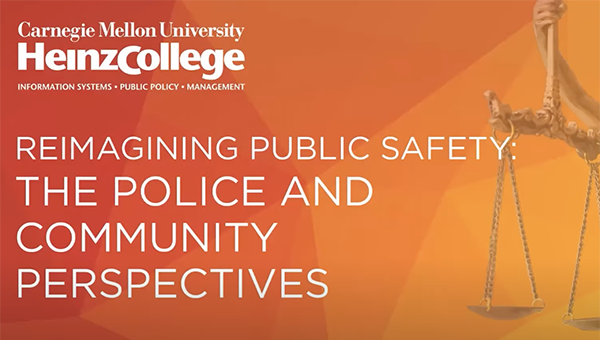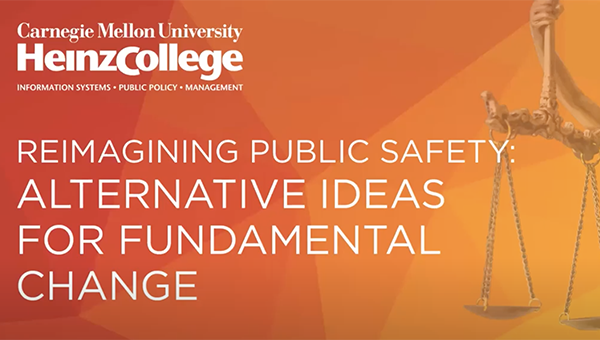Reducing Inequalities in the Justice System Must Be a National Priority
By Scottie Barsotti
On the question of how to reimagine public safety, award-winning criminologist Dan Nagin believes the answer lies in policies that address inequities in criminal justice while realigning incentives, rather than doubling down on the status quo.
Policing and criminal justice reform have been driving our national dialogue. The protests in summer 2020 in response to the murder of George Floyd dramatically changed the country’s politics, elevating awareness of racial disparities in the justice system, as well as other areas like health care and housing.
When President Joe Biden took office, one of his first actions was to issue an executive order that purports to ban the federal government’s use of private prisons.
Dan Nagin, award-winning criminologist and Heinz College professor of statistics and public policy, calls that move mostly symbolic, and that other policies would be far more impactful.
“The order is to prevent the government from renewing contracts with private prisons, so this isn’t a change with an immediate impact. Moreover, the federal prison system is only a small fraction of the total incarceration in the country, most incarceration is at the state and local level,” said Nagin.
“Also, most of the incarceration at the federal level is not within private prisons. The largest use of private prisons at the federal level is to house unauthorized migrants, and this order doesn’t affect that group as far as I can tell.”
Nagin notes that there is considerable use of private prisons at the state level, but said it’s unclear whether federal signals on private prisons will lead to similar action within states. Any change to states’ prison capacities is likely to run up against significant political pressure.
Regardless, reducing capacity in the federal or state prison systems in any measure will require adjustments in sentencing guidelines. Nagin suggests sentencing needs to be changed so that fewer people are being sent to prison, and for shorter periods of time—he has long advocated for reforms in the use of the life sentence specifically.
Nagin’s research shows that harsher sentences—for example, handing down a life sentence instead of a 20-30 year sentence—have no material deterrent effect on crime. He suggests that “prisons have been transformed into old age homes” as the proportion of prisoners serving life grows slowly over time, and that population continues to age.
“Just talking about Pennsylvania: in 1980, there were 848 lifers. In 2019, there were 5404. That’s an eight-fold increase,” said Nagin, citing his research. “Over that period, the percentage of prisoners over age 50 increased from 4.5 to 23.4 percent. Crime is largely a young person’s game, so this makes no sense from the perspective of public safety or crime deterrence.”
Black and other minority populations are disproportionately represented in prisons, and minorities have been particularly impacted by overuse of life sentences. Changing the life sentence, including releasing some prisoners who are currently serving life for crimes they committed decades ago, is an issue of racial justice.
“Even before COVID, prison populations had been declining, meanwhile the number of lifers hasn’t budged,” said Nagin. “We need to scale back our use of life imprisonment in Pennsylvania, and in state systems throughout the country.”
More so than the action on private prison contracts, Nagin believes it might have some real value if the Biden administration took action on reducing federal prison populations and changing federal sentencing guidelines. That could give judges more options other than incarceration, with the hope that states will follow suit.
Reimagining Public Safety
“On policing, most policing is local,” said Nagin. “However, the federal government could invest in research into measuring community sentiment at a granular level, devising ways for local police departments to effectively implement those systems, and designing systems of reward, for example with promotions, that recognize police officers who advance citizen trust in the police. ”
Such systems could help to realign incentives so that police departments and officers are rewarded for engaging with their communities and establishing trust, rather than the current structure which in many cases incentivizes arrests and an overreliance on jails.
Professor Nagin helped to create a series of conversations titled “Reimagining Public Safety” that convened experts including prominent national journalists, organizers, activists, scholars, and officials from government and law enforcement. The series examined several challenging historical and current problems pertaining to police reform. The videos of those sessions can be viewed below.
The Police and Community Perspectives
This first session discusses the critical issue of rebuilding trust between the police and the communities they are sworn to protect.

